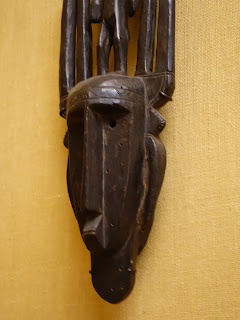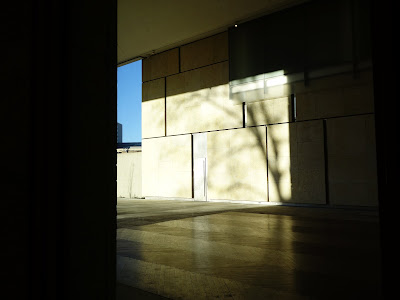The Barnes Foundation
Saturday Chris attended a workshop, and I took the day to explore Philadelphia. I walked him to the location of the workshop then went further on to the Barnes Foundation, a museum I'd heard of, watched a film about, but had never been to.
The art in the museum was collected by Albert Barnes. The museum website writes: "Born into a working-class family in Philadelphia, Albert Coombs Barnes (1872–1951) showed his intelligence and drive early on. He was accepted to the prestigious Central High School, graduated from medical school at the University of Pennsylvania, and went on to study chemistry in Germany. He made his fortune by co-inventing the silver-based antiseptic Argyrol with his German colleague Hermann Hille." He began collecting art, then, "a progressive employer, Dr. Barnes organized his workers' day to include a two-hour seminar in which they would discuss the writings of philosophers like William James and John Dewey, and examine original works of art."
He built a museum on the grounds of his home in Marion, PA, but a few years after his death, a new building was constructed in Philadelphia to house his astonishing collection. There is a fascinating movie called "The Art of the Steal" which tells one version of the story of how the art came to Philadelpia. I didn't get further information about that story at the museum, but it was an interesting back story to have in mind as I went through the building which was constructed to have precisely the same size galleries as Dr. Barnes had in his museum. The art is hung as he had it hung as well. That was one of the most fascinating things about the museum - the way the art was hung. There are many pictures on each wall - maybe 20 or so - hung symmetrically, so if there's a VanGogh on one side, I knew to expect one on the other side. Interspersed throughout is furniture and metalwork - things like andirons and hinges and locks! Supposedly he used those objects to focus the viewer's attention on specific pieces or on certain aspects of the pictures. He was an adherent to John Dewey's educational system and believed in experiential learning which his galleries were supposed to promote. I did find myself noticing certain aspects of the paintings which I might not have otherwise noticed due to the way they were hung. It was fun trying to figure out what he might have had in mind.
Here's an example:
I love this picture by Toulouse-Latrec! The woman's expression captures me - I want to know the story! Then, next to it is hung this fork with the bent prongs - bent at just about the exact same angle as her bangs are! I might not have noticed the bangs except for the fork's tongs which accentuated my awareness and made me pay more attention to them.
And another: (Again, I apologize for the poor layout - Blogger is not allowing me to move pictures as I want to!)Barnes collected a large number of African masks. He was very well aware that artists such as Picasso and Modigliani were looking at and studying these masks and that their art was influenced by them. He hung the paintings of Modigliani and Picasso next to the masks to help viewers notice the similarities. In most museums, pieces are hung by genre or country of origin, or at the very least, by time period. Barnes ignored those conventions in order to help us understand the connections between older and contemporary art - artists study the art that has come before them to help them learn - what a great thing for us viewers to be able to see what influenced them and how they used those influences.


The building itself was also a work of art. It appeared to me that great attention had been given to creating a beautiful space with special views through to other areas. I enjoyed discovering those as I went along.
 The original museum didn't have these passageways with live trees growing in them. The architects of this building added them to provide more room for viewers to move throughout the space. It was also nice to see a bit of nature in the midst of so many paintings. My mind definitely needed a moment's respite from the fabulousness of the art.
The original museum didn't have these passageways with live trees growing in them. The architects of this building added them to provide more room for viewers to move throughout the space. It was also nice to see a bit of nature in the midst of so many paintings. My mind definitely needed a moment's respite from the fabulousness of the art. The entrance/exit hallway is visible from the stairway, creating a vignette I was delighted to capture as this woman walked by.
The entrance/exit hallway is visible from the stairway, creating a vignette I was delighted to capture as this woman walked by.
Here are some examples of the metal work hung with the artwork. The cage above the exit sign is a confessional cage. I don't know what that means, but it's very name gives me the creeps!
 I don't know what this is, but there were two, one on either side of the wall, next to similar paintings.
I don't know what this is, but there were two, one on either side of the wall, next to similar paintings. And example of how pieces were hung with the metalwork interspersed and furniture alongside it. I've never seen another museum like this!
And example of how pieces were hung with the metalwork interspersed and furniture alongside it. I've never seen another museum like this! There were so many pieces by famous artists there, I began to get lacadaisical about them. 100's of Renoirs, scores of Picassos and Matisses. Several Van Goghs, Cezannes, Corbets, etc. It was difficult to process all the great art. What I did tend to notice, ironically, was the art that wasn't so good, or that was oddly different. For example, this oval framed piece by Van Gogh. The woman's body is quite unsual. I don't know if she was truly built this way or if this was an early painting and not as skillful as he might have done later. Either way, I was captivated by this one because of its very crudeness.
There were so many pieces by famous artists there, I began to get lacadaisical about them. 100's of Renoirs, scores of Picassos and Matisses. Several Van Goghs, Cezannes, Corbets, etc. It was difficult to process all the great art. What I did tend to notice, ironically, was the art that wasn't so good, or that was oddly different. For example, this oval framed piece by Van Gogh. The woman's body is quite unsual. I don't know if she was truly built this way or if this was an early painting and not as skillful as he might have done later. Either way, I was captivated by this one because of its very crudeness. And this Renoir painting of fruit. As I mentioned a few days ago on this blog, I have my students draw fruit each time I teach pastels, so I've seen a large number of drawings of fruit. I think many of my students have done finers drawings of it than this one by Renior. It's good to see that not everything the masters does is fabulous, or even particularly good. It's comforting for those days when I'm not doing my best work!
And this Renoir painting of fruit. As I mentioned a few days ago on this blog, I have my students draw fruit each time I teach pastels, so I've seen a large number of drawings of fruit. I think many of my students have done finers drawings of it than this one by Renior. It's good to see that not everything the masters does is fabulous, or even particularly good. It's comforting for those days when I'm not doing my best work! I don't run into such a complicated tangle of buildings, trees, cars, people, lights, bushes in Richmond too often, so it was hard for my eyes to come to terms with so much chaos - especially after having been in the museum for so long where my eye had been carefully and skillfully directed from place to place.
I don't run into such a complicated tangle of buildings, trees, cars, people, lights, bushes in Richmond too often, so it was hard for my eyes to come to terms with so much chaos - especially after having been in the museum for so long where my eye had been carefully and skillfully directed from place to place.
Lots of Revolutionary War momentos in the city, like this statue of a polish soldier who helped the Americans in their fight against the British.
I had fun trying to get a good shot of the reflection of this dome in the mirror-sided building to its left.














